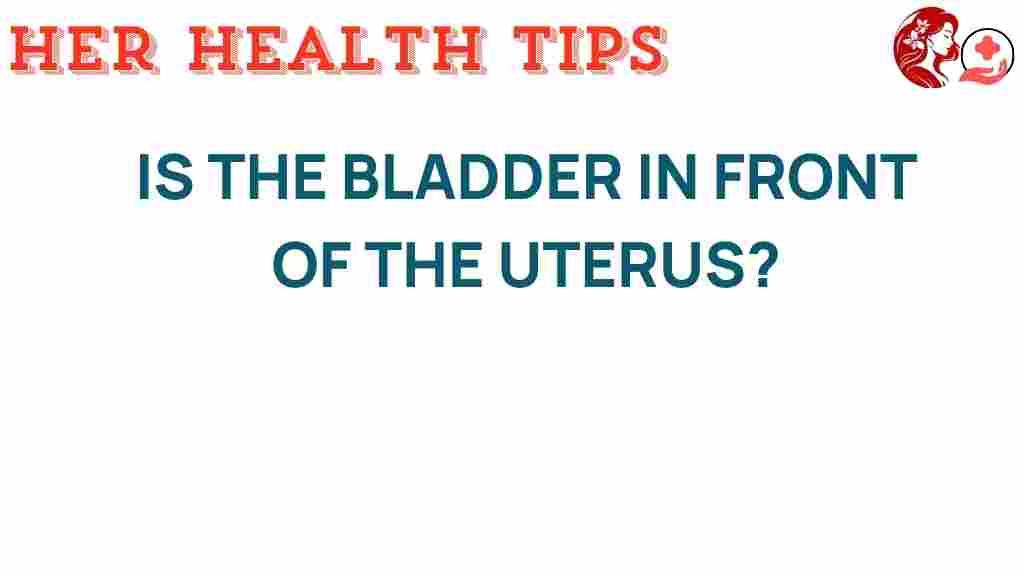The Hidden Anatomy: Is the Bladder Really in Front of the Uterus?
Understanding bladder anatomy is crucial for women’s health, especially when discussing the relationship between the bladder and the uterus. Many people operate under the assumption that the bladder is positioned directly in front of the uterus, but the reality is more complex. This article will delve into the pelvic structure, the positioning of the bladder and uterus, and the underlying facts about female anatomy and health.
An Overview of Female Anatomy
The female reproductive system is intricate, composed of several organs that work in harmony. The primary components include:
- Uterus
- Ovaries
- Fallopian tubes
- Vagina
- Bladder
Understanding how these organs are positioned relative to one another is essential to dispel common medical myths and provide clarity on women’s health.
Pelvic Structure and Organ Positioning
To understand the positioning of the bladder and uterus, we must first examine the pelvic structure. The pelvis is a basin-shaped structure that supports the weight of the upper body and houses various organs. Here’s how the primary organs are arranged:
- The **bladder** is located in the anterior (front) part of the pelvis.
- The **uterus** is situated posterior (behind) and superior (above) to the bladder.
- The **ovaries** are located laterally (to the sides) of the uterus.
This positioning leads to the conclusion that while the bladder is in front of the uterus, they are not aligned in a simple front-and-back relationship. Instead, they occupy distinct planes within the pelvic cavity.
Bladder Anatomy: Understanding the Basics
To grasp the dynamics between the bladder and the uterus, it’s essential to delve deeper into bladder anatomy.
Key Components of the Bladder
The bladder is a muscular sac that holds urine. Its key components include:
- Detrusor Muscle: The smooth muscle responsible for bladder contraction.
- Trigone: A triangular area at the base of the bladder that is sensitive to stretch and signals the need to urinate.
- Urethra: The tube that carries urine from the bladder to the outside of the body.
Functionality of the Bladder
The bladder’s primary function is to store urine produced by the kidneys. It can hold about 400-600 mL of urine in a healthy adult. Upon reaching capacity, nerve signals prompt the urge to urinate.
Uterus Position: A Closer Look
The uterus is a hollow, muscular organ where a fertilized egg implants and develops during pregnancy. Its position can vary based on several factors such as age, hormonal changes, and childbirth. Here are some important aspects:
- Position: The uterus is typically tilted forward (anteverted) but can also be retroverted (tilted backward).
- Size: The average size of the uterus is approximately 3 inches long and 2 inches wide, adapting its size during pregnancy.
Common Myths About Bladder and Uterus Position
Several anatomy facts related to the bladder and uterus are often misunderstood. Here are some common myths:
- Myth #1: The bladder is always directly in front of the uterus.
Fact: The bladder is positioned in front of the uterus, but they are separated by connective tissue and the pelvic floor. - Myth #2: A full bladder can push the uterus out of place.
Fact: While a full bladder can cause discomfort, it does not typically displace the uterus significantly. - Myth #3: The position of the uterus is the same for all women.
Fact: Uterine position can vary from woman to woman based on anatomy and health conditions.
The Relationship Between Bladder and Uterus
Given their proximity, the bladder and uterus can influence each other’s functionality. Here are several factors that highlight this relationship:
Pelvic Floor Health
The pelvic floor is a group of muscles that support the bladder, uterus, and rectum. Weakness or dysfunction in these muscles can lead to:
- Urinary incontinence
- Pelvic organ prolapse, where the bladder or uterus descends into the vaginal canal
Maintaining pelvic floor strength is essential for overall female health.
Pregnancy and Its Impact
During pregnancy, the uterus expands significantly, which can lead to increased pressure on the bladder. This is why many pregnant women experience:
- Frequent urination
- Increased urgency
Understanding how these organs work together during pregnancy can help manage discomfort.
Steps to Maintain Bladder and Uterus Health
To ensure optimal health of both the bladder and uterus, consider the following steps:
- Stay Hydrated: Drink plenty of water to help maintain a healthy urinary system.
- Practice Pelvic Floor Exercises: Kegel exercises can strengthen pelvic floor muscles.
- Regular Check-Ups: Regular gynecological visits can help monitor reproductive health.
- Manage Weight: Maintaining a healthy weight can reduce pressure on pelvic organs.
Dietary Considerations
Nutrition plays a vital role in maintaining bladder and uterine health. Consider incorporating:
- Fiber-Rich Foods: To prevent constipation, which can impact pelvic health.
- Fruits and Vegetables: To provide essential vitamins and minerals.
Troubleshooting Common Issues
If you experience any issues such as frequent urination, pelvic pain, or urinary incontinence, consider the following troubleshooting tips:
- Track Symptoms: Keep a diary of symptoms to discuss with your healthcare provider.
- Adjust Fluid Intake: Monitor your hydration levels and fluid intake timing.
- Seek Professional Help: Consult a urologist or gynecologist if issues persist.
Conclusion
In understanding the bladder anatomy and uterus position, it is clear that while the bladder is indeed located in front of the uterus, the relationship is nuanced and influenced by various factors. Dispelling medical myths about these organs can empower women to take charge of their women’s health.
Staying informed about the pelvic structure and maintaining a proactive approach to health will lead to better outcomes in the long run. For more information on female health and anatomy, consider visiting this resource and remember to consult your healthcare provider for personalized advice.
By understanding the anatomy and addressing common concerns, women can enhance their reproductive system’s health and overall well-being.
This article is in the category Reproductive and created by HerHealthTips Team
